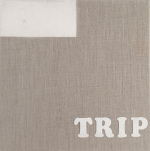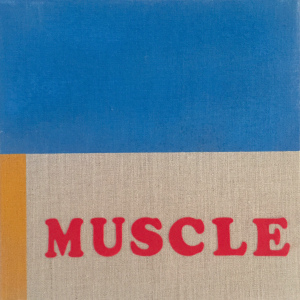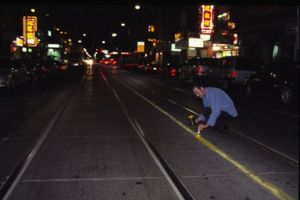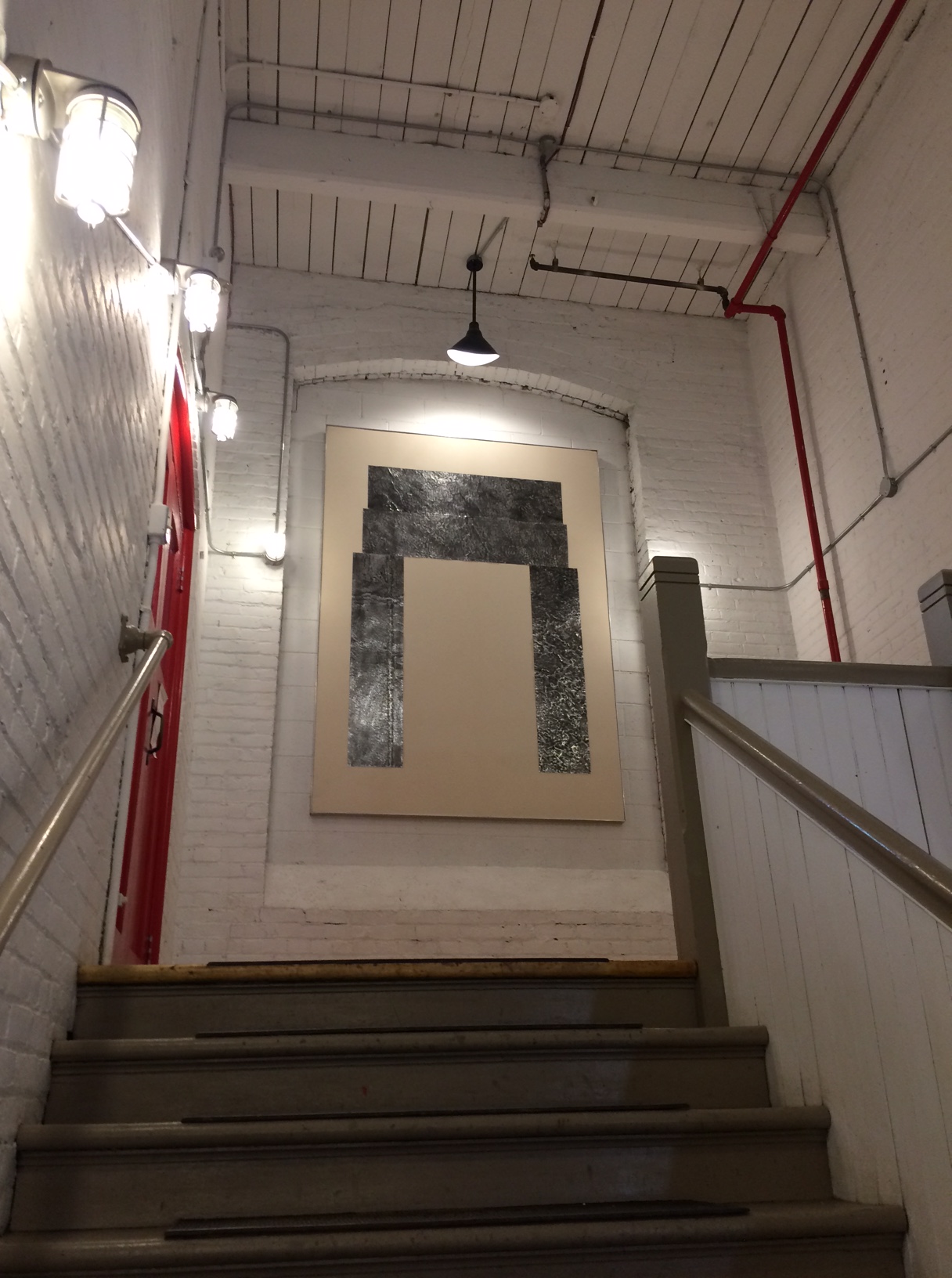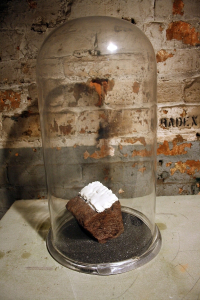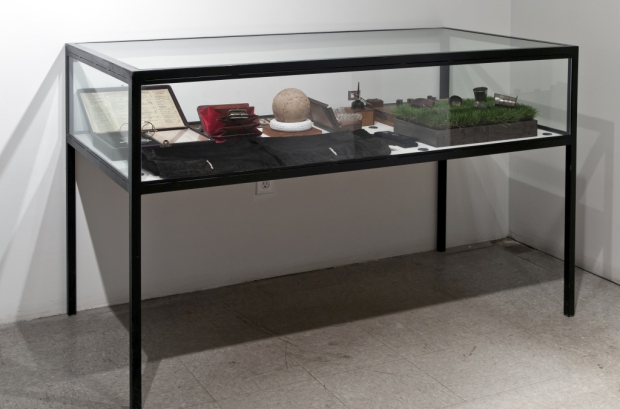mar
SAME BRUSH IN THE SAME HAND OF THE SAME MAN WITH THE SAME CAN.
Line markers are terra tatoos. Surfaced with the certainty of a civic gavel. Ribboned by warrant, global margins in, out, to and from a city… Gaia’s constant enfaced endemic enclaves – ensigned, endorsed…an earthly entente cordiale. Paint to point.
Graffiti is a love story. Philadelphia the first courtship balcony. An aerosal aka first branded in and on the city’s means in order to win one heart, yet turn many heads. Cornbread conceived. Paint as poesy.
Two painting-in-the-world acts: One deemed modern and minimal, requisite in its communication means. Borders and boundaries directing pace and permission. The other, all vigour and visually copious yet in its illegality contemplated as impairing, vitiating. Borders and boundaries directing pace and permission.
From abode to street, painted codes are encountered by foot or by other… it’s BREAD AND BUTTER, READ AND UTTER.
Graffiti is cross-culutral, cross-class, cross-race, cross-age. Line markers are simply planet.
Graffiti sings… line markers hum.
Line markers are all plot. Graffiti is plot and character.
Graffiti is all bio – the individual highlighted and championed, a chromatic chronicle…‘me’ language but with a mirror facing out. Line marking is one bio, a 1911 bio, but then all masses, civic, menial, stoic, industrious unfaces.
Graffiti is performance; an unwilling collaboration with architects. Line marking is duty; an unwilling collaboration with the public.
Graffiti is not about ownership, but about lack of ownership. Line marking owns the road.
Line markers and graffiti are linguistic inflections – different accents, different twangs but the same mouths. MARKER / GRAFFITI = MARFFITI.
fee
THE HIGHWAY IS THE MARGIN. THE LINE MARKER, THE WAYFINDER. GRAFFITI, THE PATOIS.
* When the U.S.A. Highway Act of 1956 unveiled a 13-year plan for a 41,000-mile interstate highway system at a cost of 13 billion dollars, it dictated that miles upon miles of highway would be laid across the country, significantly through New York City. A sort of road requiem. What resulted was the division and corralling of poor communities; providing for the flight of the white urban middle class to the suburbs. Case in point: The Bronx.
Divided by three separate highways, the Bronx became a roped offed neighborhood, destroying the community fabric and much of its housing. The Cross-Bronx Expressway, officially known as I-95; was the first highway that was laid down. This new highway separated the southern area of the Bronx from the rest of the Bronx, thus grouping together Mott Haven, Melrose and Fordham Road to create what is now known as the South Bronx. The next two highways to be built were the Bruckner Expressway (I-278), to the east, and the Major Deegan Expressway (I-87), to the west; these two highways finished the cordoning off of the South Bronx neighborhood. This physical isolation marked the completion of the first step in turning the South Bronx into a ghetto.
The next step in the decline was a marked decrease in the number of jobs. As of 1969, the workforce in New York City was at a strength of 3.8 million, roughly the same as it had been in the 1950’s. However, it subsequently went into a severe 8-year decline which, in 1977, left the workforce incredibly depleted. The employment crisis was primarily the result of de-industrialization because during the late 1960s, the plethora of factories and warehouses that had been the material base for the economy and industry of New York City started to leave, pursuing cheaper land in the suburbs or cheaper labour abroad. Industry was shifting from manual labour and production to finance, insurance, and real estate which were moving into office buildings strongly benefiting the landlords…and only the landlords…like a modern-day feudalism…ALL LORDS, NO VASSALS. There was roughly a 1000 percent difference between the rent that landlords received received for class A office space and the rent for factory and warehouse space. So, during the early 1970’s, there was a boom in the construction of office buildings. But, like the real estate boom and bust in Harlem in the 1920’s because of overproduction, this eventually busted as well. NO LORDS, NO VASSALS and a lot of empty buildings in the corral.
In ‘77, when unemployment peaked, jobs for middle and upper-middle class Manhattan residents were still available. It was the working man who suffered because the overwhelming majority of jobs left New York with the factories. The South Bronx in particular was left with masses of jobless blue-collar residents. The consequences of this were horrible, because the financial situation of the city was so bad, that the jobless would remain unemployed, shoving the neighborhoods like the Bronx further into poverty. Jobless people had nothing to do: they were unemployed and highways essentially shut in their neighborhood from all sides. The more rapid the neighborhood deterioration, the greater the institutional disinvestment. Neighborhoods plagued by heavy abandonment were then identified as areas that should not receive or be recommended for mortgage loans or insurance. Problems that undermine social organization ranging from crime, gang violence, drug trafficking to family breakups became the norm. And the youth of the jobless? How to be heard all these years? How to state that one was still here? Graffiti was one way to ante up. * content nod to Willy F.
tea
FUCK THE NOMADIC MUSINGS. THIS MOLESKINE IS USED TO COLLECT BETS.
The concept of the ‘ideal city’ embraces the circle, the radial, the concentric (Sforzinda). Military might and maximum mobility the shape logic.
Graffiti and the line marker inhabit the world of the rectangle and the square. They groove the right angle.
The circular canvas is art history’s ghetto.
X and Y axises in the urban Cartesian grid, the line marker and graffiti approximate each other like distant cousins, a happenstance, together from a common painted pool. One thought of as vertical and the other always horizontal; they are tags in time if not actually in creative step. Their worldly existence is a blend of the stoic and everywhere with the yell and the selected locale, composed purposely like a raised voice in an argument. The bricks, the concrete, the asphalt are the breather in between rounds.
Graffiti is all about verticality. All ‘Y’ axis. Getting up. Writers walk routes – in a horizontal way – but their dérive, their crowns, are roofs, stairs, stories in breeze-ways, bridges, the seemingly unreachable, vertical VICTORY.
‘Y’ for yard. ‘Y’ for year. ‘Y’ for youth. ‘Y’ as the sometime vowel. ‘Y’ as a prefix with perfective, intensifying, collective force. Yclepe. Yclad… in words.
Line marking is all horizon…all ‘X’ axis with one name known, not unknown (Hines). For foot and wheel, parallel and perpendicular, subliminal, noetic, city and country the wayfinding codes are the accepted bucket paint lines on our graph paper world.
“X marks the spot. ‘X’ like a civic ballot. ‘X’ for extra. ‘X’ for a rated, kissed, errored, magnified, multiplied on and on and on…line.
Hyphened together on canvas they are a companionate marriage, no debt and no promises to occur again. Visually mulish yet still susceptible graffiti changes the line marker from all function, all language, all business and dips it in an aesthetic, even cosmetic demeanor. LINES ‘inching’ ever so close to becoming STRIPES. FIELDS becoming FILL. Graffiti styled markings accentuate their limits as emotional utterances and not cool code. Combined they are poetrusic, boughetto…MARFFITI.





